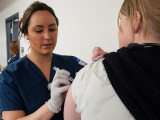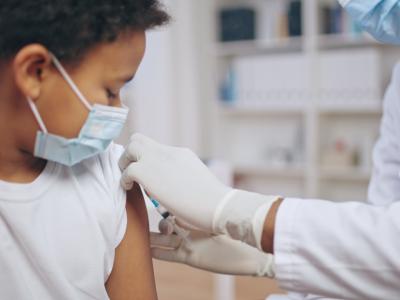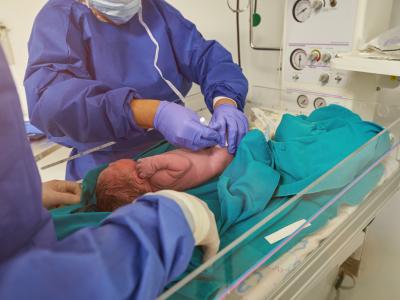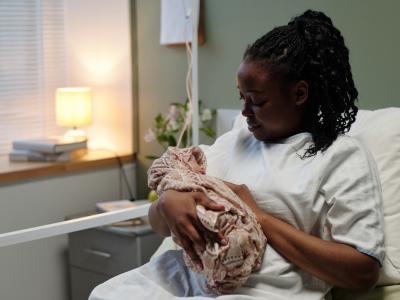A preliminary analysis indicates that this year's flu vaccine, which is not well matched to the predominant circulating flu strain, is only 23% effective in protecting people, the Centers for Disease Control and Prevention (CDC) announced today.
The agency said the finding, which is well below the typical overall flu vaccine effectiveness (VE) of around 60%, illustrates the importance of antiviral treatment for those at risk for flu complications and also points up the need for better flu vaccines. The findings were published in the Jan 16 issue of Morbidity and Mortality Weekly Report.
Two experts who were involved in the study said that although the relationship between vaccine match and effectiveness in general is not very clear, in this case the low VE probably is related to the mismatch, given that about two-thirds of circulating H3N2 viruses are "drifted" from the H3N2 component of the vaccine.
They also said that even with this low VE, the vaccine can provide some protection and potentially prevent thousands of hospitalizations.
"Maybe it's a glass half full versus half empty, or maybe 23% full and 77% empty, but we're very confident that the vaccine is providing some protection," said Edward Belongia, MD, director of the Epidemiology Research Center at the Marshfield Clinic Research Foundation in Wisconsin. He is involved in the CDC's US Influenza Vaccine Effectiveness Network and a co-author of the report.
Five centers involved in study
The five centers in the CDC network used a test-negative case-control design to estimate mid-season flu VE. The approach involves enrolling patients who seek care for an acute respiratory illness, determining their flu vaccination status, testing them for flu, and comparing vaccination rates in those who have the virus and those who don't.
The researchers enrolled 2,321 children and adults between Nov 10, 2014, and Jan 2. Of those, 950 (41%) tested positive for flu by polymerase chain reaction, the report says. The share who had been vaccinated ranged from 46% to 66%, depending on the study site.
Of patients who tested positive for flu, 49% had been vaccinated, compared with 56% for those who tested negative. After adjusting for several factors, including study site, age, sex, and health status, the researchers calculated that overall VE against medically attended flu was 23% (95% confidence interval [CI], 8% to 36%).
In patients who had flu, nearly all of the viruses (916, or 96%) were type A, and all of these were H3N2 isolates. The adjusted estimate of VE against H3N2 was 22% (95% CI, 5% to 35%). By age-group, VE against H3N2 was 26% (CI, 2% to 45%) in children 6 months to 17 years old, 12% (CI, -26% to 39%) in adults ages 18 to 49, and 14% (CI,-31% to 43%) in those 50 and older. Thus protection reached statistical significance only in the youngest group.
The team antigenically characterized 24 H3N2 isolates from patients in the study and found that 16 of them differed from the H3N2 component of the vaccine. They were similar to the H3N2 strain picked for the vaccine for this year's Southern Hemisphere flu season. This finding is in line with the CDC's overall antigenic characterization studies so far this season, which have shown that about 68% of circulating H3N2 isolates differ from the vaccine.
Limitations of study
The CDC acknowledged several limitations of the study, including that low numbers rendered the VE estimate for adults imprecise. In addition, the VE estimates are limited to the prevention of outpatient medical visits and don't include more severe outcomes such as hospitalization and death. Further, vaccination status information involved self-reporting at four of the sites, with resulting gaps in data on vaccination dates.
Even with low effectiveness, flu vaccination is still worthwhile, the CDC report said. It noted a CDC modeling study that suggested that a vaccine with only 10% effectiveness in older adults still could prevent about 13,000 flu-related hospitalizations in that age-group in a moderately severe season like 2012-13. So far, this season is very similar to that one, the authors said.
At the same time, the article observes, "Although influenza vaccines are the best tool for prevention of influenza currently available, more effective vaccines are needed."
The report also said the findings highlight the importance of antiviral treatment for hospitalized patients and for outpatients who are at risk for flu complications, a theme the CDC has been stressing lately. High-risk groups include the elderly, young children, pregnant women, and those with chronic illnesses, such as asthma, diabetes, and heart disease.
Estimate well below previous seasons
Brendan Flannery, PhD, first author of the report, said this is just the third flu season in which the CDC has published an early-season estimate of VE. The early estimates, he said, were much higher in the past two seasons: 62% in 2012-13 and 61% in 2013-14.
In the past two seasons, the final VE estimates came out a little lower than the preliminary numbers, said Flannery, who is an epidemiologist and co-investigator for the Influenza VE Network and with the CDC's Influenza Division. The difference might have been due to more complete data on vaccination status and some additional variables included in the final estimates, he suggested.
He said the CDC does believe the low VE is related to the vaccine mismatch with circulating H3N2 strains. "It's not consistent that drifted viruses necessarily mean a low vaccine effectiveness, but . . . this estimate is consistent with how different the virus seems to be," he said.
"We hope it does not cause people to lose confidence in flu vaccines," Flannery said. He added that the vaccine still offers protection against flu strains similar to those in the product, including influenza B, which often becomes more active late in the season.
Belongia, of the Marshfield Clinic Research Foundation, said his center has been doing flu VE studies since the 2007-08 season, and this year's preliminary estimate is the lowest he has seen.
He said the preliminary estimates "give a reasonably good ballpark estimate of how the vaccine is doing," usually proving to be within a few percentage points of the final estimates calculated after the season.
Belongia agreed with Flannery that, while the overall correlation between vaccine match and effectiveness is blurry, the low VE seen this season probably is related to the mismatch. "There's maybe less ambiguity when there's a substantial antigenic difference, and that's the case here," he said.
He hopes to come up with better data soon on the link between vaccine match and VE.
"We hope to have genetic sequencing data for all our influenza A cases at the end of the season so we can look at different clades that correspond to different antigenic groups, and calculate vaccine effectiveness separately," he said. "If we have enough cases to do that, it'll be very interesting, because it'll actually tell us if we have high vaccine effectiveness for those strains similar to the vaccine strain. . . . Then we can really make some inferences about the effect of drift on vaccine effectiveness."
Meanwhile, he acknowledged that the low VE findings aren't likely to help public confidence in flu vaccines.
"It's certainly a concern, because this is a complicated public health message, and people who aren't really tuned in may think [vaccination] is not important," he said. "But flu is a potentially serious or deadly disease, and even a flu vaccine with low effectiveness can prevent thousands of hospitalizations.
"Certainly we need a better vaccine. [But] we've shown with this report that even though effectiveness is low, there is some protection from the vaccine. Anything we can do to prevent flu is important."
Belongia noted that the CDC Flu VE Network is preparing a report for the World Health Organization committee that will select the strains for next season's flu vaccine. It will include data from Canada and Europe as well as the United States, with the aim of giving the panel as much data as possible on VE.
CDC. Early estimates of seasonal influenza vaccine effectiveness — United States, January 2015. MMWR 2015 Jan 16;64(1):10-15 [Full text]
See also:
Related Dec 5, 2014, CIDRAP News story on vaccine mismatch





















